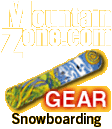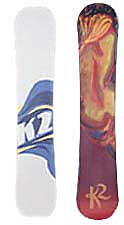
Gear Home SEE ALSO:
Marketplace
Contests
Auctions
ISF Schedule
FIS Schedule
Full Schedule
Ski Resorts


This Board's For You: How to Choose
 Todd Richards works his board |
Snowboarding should be about passion, but if you're in the market for a new board this season you should also know the basics of selecting the board that suits the way you ride. Instead of trying to review all the boards out there, we've asked some manufacturers to explain the principles they take into account when they're designing boards. Below is a short list of guidelines to memorize in preparation for this season's board shop bro-down.
It's a Good Year to Buy a Board The design trends this year point toward a preference for all-mountain freeride/freestyle performance. Manufacturers are making boards designed for floating over powder, sprocking through the park, and holding an edge down a groomer. Designs are also leaning toward directional constructions. This means a board will feel even more in control going forward, while not precluding being able to ride or land jumps switch.
A directional board has its stance slightly set back from center, and sidecuts that make the board easy to handle going forward. Morrow's Product Manager, Sanders Nye, said that their riders were actually having an easier time landing things switch on directional boards. If you spend 80% or more of your time riding forward, then a directional board is for you.
The one-board-for-all-conditions approach is great for advanced riders who are looking to improve on the board they ride 90% of the time, and even better for riders who can only keep track of one board at a time. While specialty boards — for powder, freestyle, or racing — continue to improve, manufacturers have put a lot of work into innovating and increasing their all-mountain selections this year. If you've been waiting to step up and get a new board, this is your year.
It's All in the Foot, Baby It used to be that if you had a big foot, you had to get a big, long board to keep your toes from hanging over the side. Little feet, short board.
Well, the purgatory is over.
K2 Fatbob, K2 Luna As we approach the millenium, width becomes more important than length. |
Cameron Andrus, one of K2's board engineers, explained that by getting your toes and heels close to the edge without going over, you can transfer your body's energy to the rails more directly. Your board will be more responsive, and you won't suffer from club-foot or peg-leg syndrome.
When you're looking at boards, look at the waist width before you look at length. With a wide deck and more aggressive sidecuts, a 163 cm board today rides like a 168 made three years ago. And a shorter board is a lot easier to spin, to turn through the trees, and stash in a Yugo.
Getting Effective If length isn't that important, then what is? Every board has an effective edge measurement that tells you how many centimeters of edge you'll be able to set in the snow while you're turning. The more aggressive the sidecut, the longer the effective edge. If you're only into Alaska heliboarding through uncut powder, then a longer board has more meaning because you don't set an edge on powder. But if you're carving through ice, crud, or groomed slopes most of the time, you need to pay attention to this measurement and forget about the board's overall length.
Come Flex with Me! During the bro-down, it's required that you flex the board. Just is. Ask the shop if they have two sawhorses and a 20-pound sledge. Then watch for the kickback when the hammer zings back past your ear.
Bending a board isn't about seeing if it will break. You're actually looking for two things. First, hold the nose of the board and with your other hand push on the center. Take note of how much it bends in the middle versus at the tip and tail. A stiffer middle will results in a burlier-riding board. Also, pay attention to how quickly the board snaps back. The more quickly it returns, the more boost you'll have ollying off jumps. A damper board (less snap) will be more forgiving.
Next, get the salesbro to hold the tail of the board while you hold the tip. Twist the board in one direction, while he twists it in the opposite direction. This will show you how much torsional stiffness the board offers. If you like to hit jumps on one edge or the other (most common for spinners), a board with more torsional stiffness with help you achieve the amplitude required to finish the trick. If you're staying out of the air, or tend toward busting straight airs, then a softer board is for you.
Burton Supermodel 63 This board is juuuust right. |
Scott Barbieri, Burton's Senior Design Engineer for Snowboards, says that most boards are stiffer than they have to be, and it's always better to err on the side of a softer board. East Coast riders (ice-lovers) should look for a stiffer board than West Coasters (oatmeal-eaters), but in general, the softer the board, the more forgiving it will be in every aspect of riding. And forgiveness is often redemption.
Attitude Check Claude Morgan and the Blast is a band I used to follow around during high school. Older brother's drivers license, old clothes from the thrift shop, that heady feeling you get from drinking your first beers in public...Anyhow, during the middle of the set Claude will yell out, "Attitude Check!" and the crowd will respond by holding up their middle fingers and yelling back at Claude "@#$% You!"
I later learned that underage drinking and swearing are bad things, but an attitude check is vital when you're making a snowboard purchase. You should already know what type of athletic attitude you have — aggro, goofball, or somewhere in between — and you should look for a board that fits this style.
Morrow Todd Richards 158 Todd's history teacher told him he had a bad attitude. Now he makes history. |
Budget Check Read this part if you care about money.
Nye (Morrow) tells us that one of the biggest manufacturing costs in a high-end board is a sintered or graphite base. These bases are harder, hold wax better, are easier to repair, and go faster when they're waxed. But left unwaxed, they actually ride slower than an unwaxed extruded base.
Boards that include torsion bars or high-grade fiberglass wrapping the cores are generally designed to help you achieve amplitude in the pipe or on jumps. If you plan to stick to the trails and maybe jump a few CAT tricks, spend your money instead on another lift ticket, some sweet boots and bindings, or a new shell.
Construction methods have improved greatly over the years, resulting in boards whose life spans are determined by how many times you tune the edges rather than when they'll break. With the established manufacturers, it's hard to go wrong with any board as long as it fits your foot and your style of riding.
— Jim Humes, Mountain Zone Correspondent